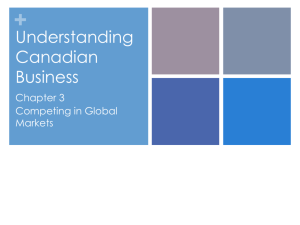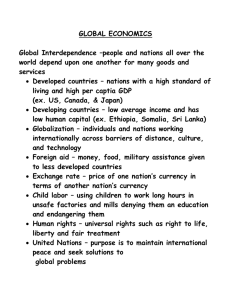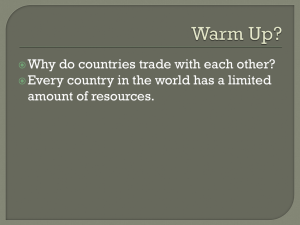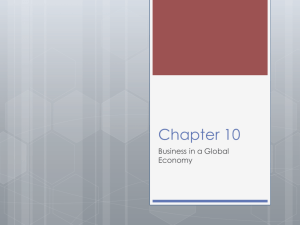Economic environment
advertisement
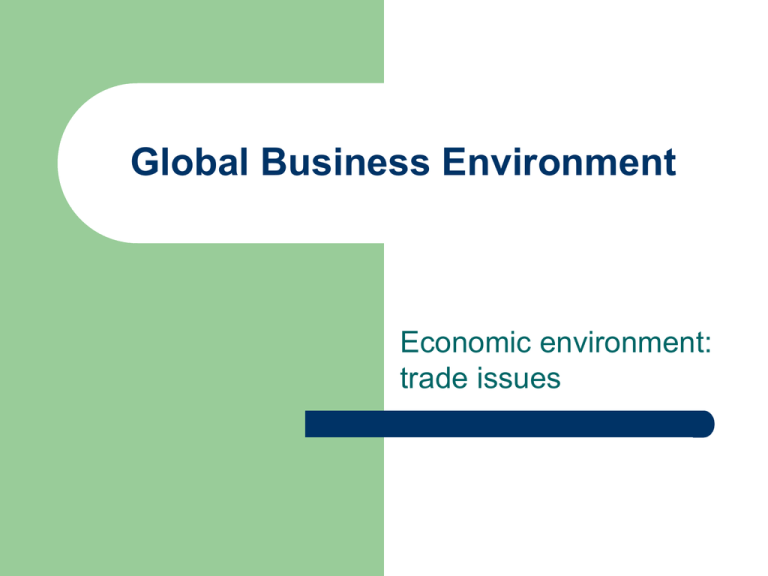
Global Business Environment Economic environment: trade issues Readings – World Trade Report 2009. Executive Summary. http://www.wto.org – GYÖRGY MIKÓSDI: The Financial Crisis and International Trade. Development and Finance 2009/2. www.ffdf.mfb.hu – GÁBOR OBLATH - LILLA JUTKUSZ: Terms of Hungarian Foreign Trade in the Long Run and in the 1990s.. Development and Finance 2003/3. www.ffdf.mfb.hu Economic environment 1. 2. 3. 4. 5. 6. The changing nature of international business/trade in historical perspective, Changing world output and world trade; International institutions; International monetary environment, financial flows, Foreign Direct Investment (FDI) trends; Business cycles; Development and competitiveness indicators; Economic integration; Global problems; Economic Risk Economic environment - Trade 1. 2. 3. Close linkages through trade in goods and services, through flows of money, and through investment than ever before liberalisation and globalisation. When a buyer and a seller engage in a voluntary transaction, both receive something that they want and both can be made better off. Trade is predicted to benefit a country by making it more efficient when it exports goods which use abundant resources and imports goods which use scarce resources. Economic environment - Trade 4. When countries specialize, they may also be more efficient due to large scale production. 5. Countries may also gain by trading current resources for future resources (lending and borrowing). Economic environment - Trade 6. Trade is predicted to benefit countries as a whole in several ways, but trade may harm particular groups within a country. – International trade can adversely affect the owners of resources that are used intensively in industries that compete with imports. – Trade may therefore have effects on the distribution of income within a country. – Conflicts about trade should occur between groups within countries rather than between countries. – But less developed countries generally loose in free trade! Economic environment - Trade 7. Explanations of trade – Differences in climate and resources can explain why Brazil exports coffee and Australia exports iron ore. – Differences in labour productivity may explain why some countries export certain products. – How relative supplies of capital, labour and land are used in the production of different goods may also explain why some countries export certain products Economic environment - Trade Economic theory on free trade versus protectionism – Mercantilist: importing leads to a decrease of national welfare; Importing will lead to an outflow of gold/money; Trade is a zero-sum game: One country wins, the other one loses; Because of this, countries should try to minimise imports and maximise exports as much as possible; The objective is to achieve trade surplus = exportoriented economic strategy. Economic environment - Trade Classical economics: Adam Smith’s “theory” of absolute advantage. – If the Netherlands can produce beer better/cheaper and Spain is better in wine, the Netherlands should specialise in beer and Spain in wine; The total production of beer and wine will increase and will lead to a win-win situation. Economic environment - Trade – David Ricardo: theory of comparative advantages Even in a situation in which country A is more efficient (cheaper) in all products compared with country B both countries will benefit (increase their welfare). A country’s production pattern is determined by comparative advantage. Economic environment - Trade – – Factor-Proportions theory: A country with a lot of supply (=cheap) of labour will concentrate on labour intensive production, a country with relatively more capital will specialise in capital intensive products. Economies of scale (i.e. lower unit costs with larger output) give countries an incentive to specialize and trade even in the absence of differences between countries in their resources or technology. Economic environment - Trade Free trade versus protectionism Arguments for free trade: 1. 2. 3. Efficiency Additional gains (economies of scale, competition) Costs of distorting trade Historical fact: the world’s three largest market economies all began their industrialisation behind trade barriers. Economic environment - Trade Argument against free trade 1. Infant industry argument A country may have a potential comparative advantage in manufacturing, but new manufacturing industries cannot initially compete with well established manufacturing in more developed countries 2. National defence argument Country must be self-sufficient in critical raw materials, machinery, and technology or else be vulnerable to foreign threats. 3. Maintenance of Existing Jobs Jobs in high-wage countries threatened by imports from low-wage countries Economic environment - Trade National trade policies: The role of domestic politics in formulating a country’s international trade policies. Issues: – – – Should a national government intervene to protect the country’s domestic firms by taxing foreign goods entering the domestic market or constructing other barriers against imports? Should a national government directly help the country’s domestic firms increase their foreign sales through export subsidies, government-to-government negotiations, and guaranteed loan programs? Different approaches of developed and developing states to the international legal framework governing international trade. Economic environment - Trade National Trade Policies: Export based and import substitution strategies: When industrial policy is pursued, the national government: – – – identifies key domestic industries critical to the country’s future economic growth and then formulates programs that promote their competitiveness. Special interest groups are lobbying for special subsidies or tariffs and other forms of protection Import-substituting industrialisation From World War II until the 1970’s many developing countries attempted to accelerate their development by limiting imports of manufactured goods in order to foster a manufacturing sector serving the domestic market. This strategy is known as the strategy of import-substituting industrialisation. Problems of ISI 1. A period of protection will not create competitive manufacturing sector if there are fundamental reasons why a country lacks a competitive advantage in manufacturing. (lack of skilled labor, entrepreneurs, managerial competence, etc.) These problems cannot be solved by trade policy. 2. It promoted production at an inefficiently small scale. Economic environment - Trade After World War II. trade liberalisation – – International negotiations; International trade agreements (General Agreement on Tariffs and Trade (GATT)); Most-favoured-nation treatment requiring countries not to discriminate between goods on the basis of their origin or destination; National treatment principle: Imported and locally-produced goods should be treated equally - at least after the foreign goods have entered the market. Reciprocity – limit free-riding Binding and enforceable commitments Transparency – notification Safety valves (restrict trade: non-economic, economic, fair competition Economic environment - Trade The GATT embodies a set of rules of conduct for international trade policy. Prohibitions: • • • Export subsidies (except agriculture) Import quotas (except „market disruptions”) Tariffs (any new tariff or increase in a tariff must be offset by reductions in other tariffs to compensate the affected exporting countries9. International negotiations and trade policy Preferential Trading Agreements – – Nations establish preferential trading agreements under which they lower tariffs with respect to each other but not the rest of the world. The GATT-WTO, through the principle of nondiscrimination called the “most favored nation” (MFN) principle, prohibits such agreements. The formation of preferential trading agreements is allowed if they lead to free trade between the agreeing countries. Levels of regional integrations 1. 2. 3. 4. 5. 6. 7. Preferential trade agreements Free trade agreement Customs union Common market (free movement of good, services, labour, capital) Single market Economic union (Fiscal, monetary union) Political union International negotiations and trade policy – Free trade can be established among several WTO members as follows: A free trade area allows free-trade among members, but each member can have its own trade policy towards nonmember countries. – A customs union allows free trade among members and requires a common external trade policy towards nonmember countries. – Example: The North American Free Trade Agreement (NAFTA) creates a free trade area. Example: The European Union (EU) is a full customs union. A common market is a customs union with free factor movements (especially labor) among members. International negotiations and trade policy Are preferential trading agreements good? – It depends on whether it leads to trade creation or trade diversion. Trade creation – Occurs when the formation of a preferential trading agreement leads to replacement of high-cost domestic production by low-cost imports from other members. Trade diversion – Occurs when the formation of a preferential trading agreement leads to the replacement of low-cost imports from non members with higher-cost imports from member nations. Indicators of international trade I. – – – – – – – Export ratio; Import ratio; Openness to trade; Openness to world economy; Commodity pattern (structure) of trade; Geographical pattern of trade; Terms of trade is the relative prices of a country's export to import Economic environment - Trade Some facts on development of trade 1. Size Matters: The Gravity Model In fact, the size of an economy is directly related to the volume of imports and exports. – Larger economies produce more goods and services, so they have more to sell in the export market. – Larger economies generate more income from the goods and services sold, so people are able to buy more imports. Economic environment - Trade Other things besides size matter for trade: – – – – Distance between markets influences transportation costs and therefore the cost of imports and exports. Distance may also influence personal contact and communication, which may influence trade. Cultural affinity: if two countries have cultural ties, it is likely that they also have strong economic ties. Geography: ocean harbors and a lack of mountain barriers make transportation and trade easier. Economic environment - Trade 2. Multinational corporations: corporations spread across different nations import and export many goods between their divisions. 3. Borders: crossing borders involves formalities that take time and perhaps monetary costs like tariffs. – – – These implicit and explicit costs reduce trade. The existence of borders may also indicate the existence of different languages or different currencies, either of which may impede trade more. Borders increase the cost and time needed to trade. Economic environment - Trade 4. Trade agreements: between countries are intended to reduce the formalities and tariffs needed to cross borders, and therefore to increase trade. 5. Estimates of the effect of distance from the gravity model predict that a 1% increase in the distance between countries is associated with a decrease in the volume of trade of 0.7% to 1%. Economic environment - Trade 6. Has the World Become “Smaller”? – The negative effect of distance on trade according to the gravity models is significant, but it has grown smaller over time due to modern transportation and communication. – But history has shown that political factors, such as wars, can change trade patterns much more than innovations in transportation and communication. Economic environment - Trade – There were two waves of globalization. 1840–1914: economies relied on steam power, railroads, telegraph, telephones. Globalization was interrupted and reversed by wars and depression. 1945–present: economies rely on telephones, airplanes, computers, internet, fiber optics,… Economic environment - Trade 7. Changing Composition of Trade What kinds of products do nations currently trade, and how does this composition compare to trade in the past? – Today, most of the volume of trade is in manufactured products such as automobiles, computers, clothing and machinery. – Services such as shipping, insurance, legal fees and spending by tourists account for 20% of the volume of trade. – Mineral products (e.g., petroleum, coal, copper) and agricultural products are a relatively small part of trade. – In the past, a large fraction of the volume of trade came from agricultural and mineral products. Economic environment - Trade – Developing countries, or low and middle-income countries, have also changed the composition of their trade. In 2008, about 65% of exports from developing countries were manufactured products, and only 10% of exports were agricultural products. In 1960, about 58% of exports from developing countries were agricultural products and only 12% of exports were manufactured products. Economic environment - Trade • World gross domestic product (GDP) and world merchandise exports not only move in tandem, but export growth exceeds GDP growth. • Growth of world GDP is associated with an even higher growth in nternational trade. • Declines also show the same tendency
